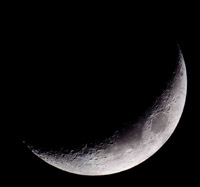Vast dark areas - the basaltic maria, or lunar "seas" - fill huge depressions in the lighter-hued and more heavily
cratered lunar highlands, or terrae.
To modern astronomers, the real importance of the moon lies in the fact that human beings not only have visited its
surface but also brought back lunar rocks for study. Between 20 July 1969, when astronaut Neil Armstrong first set foot
on the moon, and the final Apollo mission in 1972, about 700 pounds of rock and soil samples were brought to Earth.
These moon rocks contain information not just about the moon but also about the formation of our solar system. Their
chemical composition allow us to determine their age, through a technique similar to Carbon-14 dating. So far, the
oldest rocks found in the lunar highlands date to 4.4 billion years ago, the time when the moon first formed.
| |
|
 |
Full Moon
No telescope? No problem.
Here's an example of a Lunar photograph taken with a digital camera and a long zoom lens. |
 |
Moon Flight Video
A first attempt at recording a flight across the Lunar surface as a video - fasten your seatbelt! |
 |
Gassendi
Large circular crater in the Mare Humorum region featuring interesting rilles and an impressive
two-peaked central mountain |
 |
Crescent Moon
Mosaic of a pretty crescent Moon at dawn |
 |
Hadley Rille
My favourite place on the Moon. 50-mile long sinuous rille in the Apennine mountains |
 |
Albategnius
Crater formation with damaged high walls in the Ptolemaeus crater region |
 |
First Quarter Moon
View of the 8-day-old Moon |
 |
Lunar Eclipse
Photos of the March 2007 Lunar Eclipse viewed from North London |
 |
Nearly full moon
Digital camera colour shot |
 |
Straight Wall
300-meter high fault in Mare Nubium |
 |
Copernicus
Crater in Mare Insularum |
 |
Mare Nectaris
Dark lava-filled basin with relatively few sizeable craters |
 |
Schroeter's Valley
Impressive rille which winds across the moon surface for 100 miles |
 |
Two-day-old Moon
The two-day-old Moon is illuminated by Earth shine |
 |
Clavius
Dark lava-filled basin with relatively few sizeable craters |
 |
Hevelius
Large circular plain in the West |
 |
Atlas
Circular crater North-East of Mare Serenitatis |
 |
Mons Hadley
14,500ft mountain in the morning Sunlight, casting its shadow across the Palus Putredinis marsh |
 |
Hyginus Rille
Extensive rille located East of Mare Tranquillitatis region |
 |
Lunar Mountains
Mosaic of the Caucasus and Apennine mountains |
 |
Perigee Full Moon
Large full Moon at perigee - photograph taken hours after a Lunar eclipse |
 |
Phocylides
Crater trio in the South-Western quadrant of the Moon |
 |
Mersenius Rille
140-mile long rille system just West of crater Gassendi |
 Once considered a cold and inert cinder, our cratered companion lacks a substantial atmosphere
but is chemically akin to the Earth's outer layers. The moon is cooler and seismically less active than Earth,
moonquakes are less frequent and weaker than earthquakes.
Once considered a cold and inert cinder, our cratered companion lacks a substantial atmosphere
but is chemically akin to the Earth's outer layers. The moon is cooler and seismically less active than Earth,
moonquakes are less frequent and weaker than earthquakes.






























